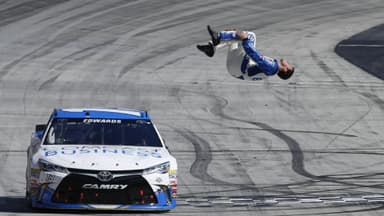Very little surprises NASCAR Hall of Famer Tony Stewart when it comes to motorsports. He’s pretty much seen and done it all if it’s been on four wheels.
Advertisement
But when Stewart was first introduced to NHRA Drag Racing, it was unlike anything he had ever experienced.
He had a great teacher in Leah Pruett, who was driving a NHRA Top Fuel dragster when she started dating Stewart, and eventually married him. The couple had their first child last fall.
Pruett told Stewart that he would not be prepared for what he’d experience once he got behind the wheel of an 11,000-horsepower, 335-mph Top Fuel dragster compared to his days racing in NASCAR.
And boy, Pruett wasn’t kidding.
“All the years that I spent in NASCAR was very similar to everything else I’d raced (like) sprint cars, Indy Cars, sports cars, a little bit here and there, ran the Rolex 24 Hours,” Stewart said on the Rubbin’ Is Racing podcast.
“Going to a NASCAR weekend’s a typical three-day weekend: you practice and qualify on Friday, have two race practices on Saturday, and then you race on Sunday.”
“NHRA is somewhat similar: you make two qualifying runs on Friday, two qualifying runs on Saturday, and then it’s like an NCAA bracket, it’s a 16-car field on Sunday. If you win your round, you go to the next round, and you’re going to run four rounds to get to the finals.”
“But I think the best way to describe it … my wife was asked (in an interview) what she thought the difference was between running a Cup car and what they do with a Top Fuel car in NHRA, and I thought the answer was really smart. She goes, “What they do in 3 and 1/2 hours (in NASCAR), we do in 3 and 1/2 seconds.”
Racing In NHRA is an Assault On The Senses for Drivers and Fans
Racing in NHRA is an all-out assault on the senses, from the burning acrid smell of nitromethane fuel that powers dragsters and Funny Cars.
And then there’s the time difference behind the wheel, yet another assault on the senses. Because most NASCAR Cup races last 3-plus hours, there’s plenty of time for drivers to adjust the way they race on a track, as well as pit stops, strategies, etc.
In NHRA, you have more things to do in just 3 ½ seconds. And if you miss even one part, your run likely goes up in smoke, or you just can’t catch your opponent in the other lane.
“What you have to react to in a 3 and 1/2 second run is way more mindboggling than I ever thought it was going to be,” Stewart said. “Literally the hardest thing about learning how to drive a Top Fuel car was the fact of you would hit the gas and your eyes aren’t even pointed in the direction you’re going.
“(It’s) like you’re looking up to the right or up to the left, depending on what lane you’re in and you see the light change and you hit the gas and then you’re trying to get your eyes on target down track, trying to figure out where you’re going.”
“One of the big in-time increments is the 330-foot cone. When you leave the starting line, the first single cone you see out there is 330 feet away.”
And before Stewart would know it, “we would be at the 330-foot cone in the car and my brain’s back at 200 feet going, ‘Wait what the hell’s going on? What are we doing?
“Literally, that was the hardest thing was to get my brain to learn how to process information as fast as my eyes were (seeing things). … You can’t decipher all of it right away in real time. … You’ve got to work up to it, and your brain learns and will train itself how to process that information of what it’s seeing.
“That was one of the things that just totally caught me off guard. I thought driving the car was going to be the hardest part, but driving the car for me was not the hardest part it, was one of the easiest parts.”
“It was the staging, the whole procedure of doing the burnout, backing up, learning how to stage correctly, and doing all this in a time frame, and then you have to react (when the green ‘go’ light flashes to start your run).”
“Another thing that is real important (is) nitromethane. Nitro cars burn a gallon of fuel every 10 seconds. Nitromethane is the heaviest fuel; it’s nine pounds per gallon, so every 10 seconds that you’re sitting there idling, it’s burnt nine pounds of weight off the front of that car, and that’s weight and balance issues at that point.
The former Cup Series driver and IndyCar racer also pointed out another one of the many unknown nuances of Top Fuel drag racing by describing how running out of fuel in one of such cars causes the engine to blow up. “So it’s like having a wick on a bomb, and if your wick’s not long enough and you run out of wick, kaboom,” he added.
Stewart was also asked about the comparison of watching an NHRA race on TV vs. in person.
“NHRA live is like on steroids compared to NASCAR live,” he said. “NASCAR live is like going to the Japanese buffet and they give you two shrimp for your appetizer, compared to going to a drag race live.”








